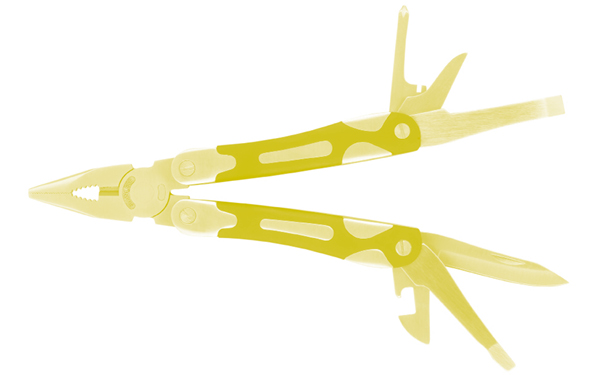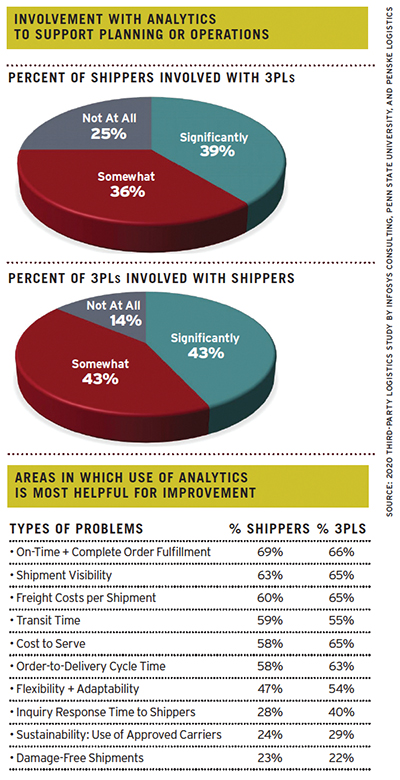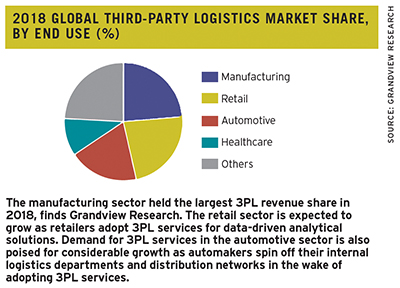3PLs Do It All

Third-Party logistics providers are building future-proof supply chains, filling their toolbox with business insights, predictive capabilities, and other new solution sets.
ANALYTICS
Analytic capabilities have become a critical technical offering for 3PLs. Nearly all—95% of shippers and 99% of 3PLs—responding to the 2020 Third-Party Logistics Study, published by Infosys Consulting, Penn State University, and Penske Logistics, say analytics are a necessary element of 3PL expertise.
By leveraging analytics, 3PLs can help shippers optimize their distribution networks. "With strategic network configuration, it’s possible to move products closer to end customers to reduce transit time and cost," says Perry Belcastro, senior vice president with 3PL Saddle Creek’s fulfillment services.
Analytics can also help shippers leverage postponement strategies and delay product customization as long as possible, so they can respond more adeptly to customer demands.
John, a logistics manager with a manufacturing company, asked his organization’s 3PL to provide a more detailed analysis of the route company’s freight and its total spend.
"We now have better information about our supply chain readily available," he says. With this information, he and his team can better determine where they can improve operations.
The analytic and supply chain solutions offered by some 3PLs can also help automate freight matching. "What is today a manual, laborious process—managing transportation service—will become highly automated," Thompson says. To be sure, some intermediaries will still be needed, particularly for specialized or complicated loads. But they’ll likely make up a smaller portion of the market.
Taking their place? "Digital freight matching has been a major focus for the past several years," says Joe Couto, COO with HighJump and Körber Logistics Systems. Sometimes called "Uber for freight," digital freight matching refers to technology that automatically matches loads with trucks without human intervention.
The digital freight- matching sector has attracted more than $180 million in venture capital investment since 2011, according to Armstrong & Associates research.
More work around analytics remains. At present, little more than one-quarter of both shippers and 3PLs are satisfied with current analytic capabilities, finds the 2020 3PL study.
One improvement that would help both 3PLs and shippers is the "neutralization" of technology, says Robert Voltmann, president and CEO with the Transportation Intermediaries Association (TIA), a trade group. That technology would enable 3PLs to take information from a carrier and present it to a shipper, no matter which systems each is using.
A TIA technical committee is working on this, Voltmann adds.
BOOSTING VISiBILITY
Many 3PLs today offer technology that provides visibility across multiple departments, says Robyn Meyer, partner in enterprise logistics, Transportation Insight (TI). These supply chain solutions help companies better compete.
Meyer provides an example: An e-commerce firm was holding frequent flash sales of a specific product. TI assessed the product’s true cost, including expenses from all departments.
The analysis showed that every time the company sold the item, it lost money. The product’s size drove up shipping costs and its high breakage rate increased the calls to customer service.
"We used technology to provide visibility to all areas," Meyer adds.
IOT & REAL-TIME TRACKING
Between 2018 and 2024, the global Internet of Things (IoT) within the logistics market is forecast to grow at a compound annual rate of 13.6%, according to Research and Markets.
Some 3PLs already are leveraging IoT. BOA Logistics, a refrigerated LTL shipment specialist, recently worked with Tive, an in-transit supply chain tracking technology provider, to implement a solution that gives BOA visibility to the temperature and locations of all its truckloads. The solution also allows the company to check delivery times and justify any detention charges.
BOA can also pair weather information with Tive’s GPS data to quickly decide whether it’s necessary to reroute or change a shipment.
TARIFFS & FINANCE
The broader economic and geopolitical environment influences shippers’ supply chains, given that many begin in one country and end in another.
While many shippers—about 70%, according to the 2020 Third-Party Logistics Study—internally manage the impact of global political decisions, 19% turn to their 3PLs. Another 20% aren’t managing it at all.
When it comes to tariffs and geopolitics, "Typically, one of the first questions customers ask is, ‘How are others handling this?’" says Sean Coakley, senior vice president, Kenco, a 3PL based in Chattanooga, Tennessee.
green measures
Regulatory requirements, public perception, and cost savings are prompting both shippers and 3PLs to make sustainability a focus of their supply chain solutions, the 2020 Third-Party Logistics Study reports.
To achieve this, 3PLs are turning to a mix of solutions, including tools that optimize routes and loads; voluntary programs like the EPA’s SmartWay; tools to track and report emissions; and the use of alternative fuels.
Eventually, some 3PLs will likely offer discounts on delivery schedules that combine orders and take slightly longer, but impose fewer environmental costs.
ROBOTICS & BLOCKCHAIN
Robots can help 3PLs address the labor challenges and space constraints many companies face, particularly in North America.
Not only are many robotic solutions less expensive than both the ongoing cost of employees and larger, automated handling systems, they can offer the flexibility and scalability 3PLs and shippers need to respond to demand fluctuations typical with e-commerce. They can also help 3PLs boost the efficiency of their employees.
"Robotics’ value proposition is savings, accuracy, and capital avoidance," says Jeff Cashman, COO with GreyOrange, a software and mobile robotics provider.
While Cashman has an incentive to tout the value of robotics, others feel similarly. The number of robotic logistics systems sold jumped 60% between 2017 and 2018 to more than 271,000 units, according to World Robotics 2019—Service Robots, an International Federation of Robotics report. These systems accounted for 41% of professional service robots sold.
Blockchain, which offers a transparent, immutable record of transactions, also shows promise as part of the supply chain solutions 3PLs offer. "I see it coming within the next few years, especially in more managed, regulated environments, such as food," says Kenco’s Coakley.
One challenge that will need to be addressed before blockchain becomes ubiquitous is that it currently exists on private, permission-based platforms.
"If the companies don’t let competitors join their platform, multiple blockchain solutions will develop," says Couto. Shippers will need to join several platforms, leading to a fragmented, more complicated environment.
VALUE-ADDED SERVICES
While the technology and expertise offered by 3PLs remain critical, service is just as important.
When Burlap & Barrel had grown enough that filling orders in the co-founders’ apartments was no longer viable, Zohar talked with a range of 3PLs, including some whose supply chain solutions handle all aspects of logistics, including fulfillment, returns, and rapid delivery. "It was compelling because we’re not fulfillment experts," he says.
The downside? "You have to fit into their machine," Zohar says. For one, Burlap & Barrel would have had to invest in special barcodes, as well as special wrapping for the glass jars it uses to ship spices. "Fulfillment costs would be through the roof," Zohar says.
Moreover, Burlap & Barrel strives to provide customers "an experience," Zohar adds. When customers buy spices online, they can’t smell, touch, or taste their purchases. So, when they receive their packages, opening it "has to feel like a gift," he says. Burlap & Barrel found a 3PL that provides white-glove service when packing the spices.
Flexibility has also been key. For instance, if Burlap & Barrel receives a shipment of jars that it won’t need for several months, its 3PL will store them.
The emphasis on customer experience is likely to intensify as millennials—those born roughly from the early 1980s until about 2000—and members of Gen Z—those born starting in the late 1990s—gain shopping power. After all, they’ve grown up in an era when they could order just about anything from their phones and find it on their doorsteps hours later.
Sales channels will continue to blur. "We’re likely to see the expansion of omnichannel, third-party marketplaces like Amazon, subscription box services, and social commerce," says Belcastro. These shifts will continue to boost the complexity of fulfillment operations.
Supply chains increasingly are like orchestras, Meyer says, quoting a speaker on the topic. "Everyone plays their own part, but without doing it together, there’s no music," she says. "That’s where 3PLs can help."



